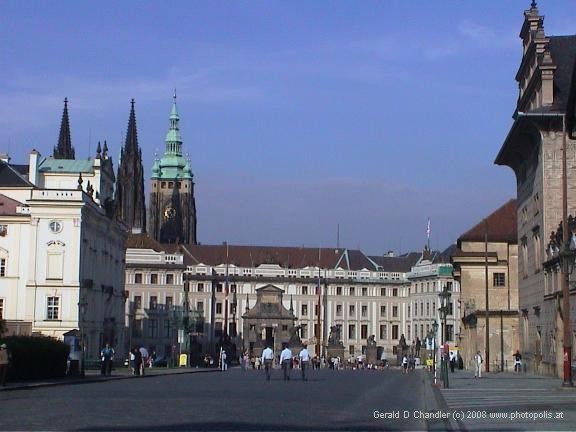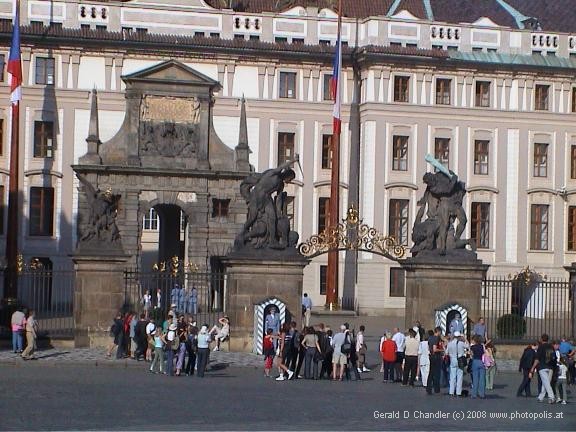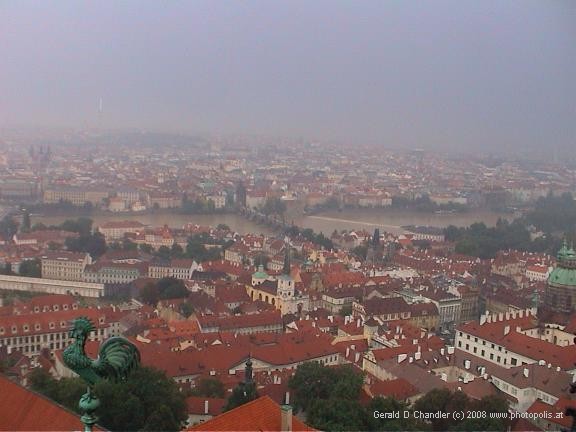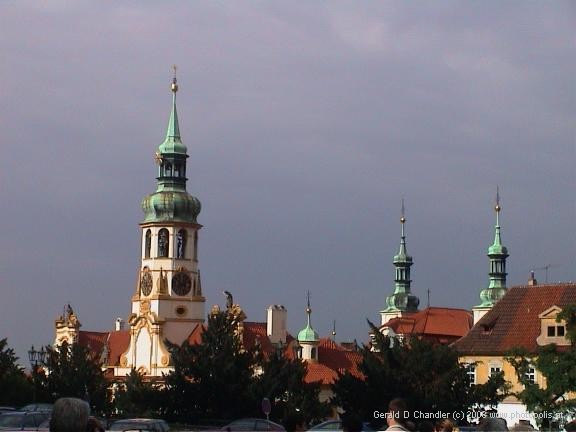Home | Front Page | Index | Blog | New | Contact | Site Map
Prague Intro
Old Town
Charles Bridge
Castle Hill
Josephov
North-East
Wenceslas Square
Vysehrad
Vltava
Foto Show

Egypt
Israel
Turkey
Bulgaria
Romania
Ukraine
Poland
Prague
Britain
USA 2002
Travel Map
What is most often simply referred to as Prague Castle is really a city within a city. Within its enclosure are numerous buildings and courtyards. The largest single one is St. Vitus's Cathedral, the home of the Prague archdiocese. Running a close second is the Royal Palace with its large and impressive Vladislav Hall. "Out back" is Golden Lane, a street where in the middle ages court workers were housed and made their wares. Saint George’s Square is one of the larger squares and gives a good view of the half-millennium old buildings. Today the Castle buildings contains several museums and the ceremonial offices of the the President of the Czech Republic,

Prague Castle and St Vitus Cathedral above Church of St Nicolas in Lesser Quarter |
Once over the Charles Bridge you are on the left bank and in the Lesser Quarter. For your first visit you should pass quickly through the Lesser Quarter and head up the hill to the Castle. There are several possible routes; don't worry about which and just take whatever turns are needed to keep you going up hill. Head for the west gate, the most impressive one. If you miss going in this way be sure to come out here and admire the gate and the the prospect of the buildings.
Later, when you descend, you can start to explore the Lesser Quarter. Some of the shops along the way offer great souvenirs at very good prices. There are several churches in the area, the largest of which is St Nicolas. This church bears the same name as one in Old Town Square, but they look nothing alike.
From St Nicolas Church (and any place further north in the Lesser Quarter) it is an easy and quick walk to the Wallenstein Gardens. At sometime or other you should get over to this lovely spot meant for lingering. Only five minutes will be long enough to appreciate its fine design. If you have more time bring your lunch or newspaper and sit for a while.
From the Wallenstein Gardens it is easy to find a bridge and walk back across the Vltava to the Old Town. Another option is to take a tram. They come frequently and don't cost much. You should be able to get a free tram, bus, and subway (tube) map in any subway station. When in the station ask about the cost of three day and weekly passes. They are very good deals.

Prague Castle and St Vitus Church from West Entrance |

Western Entrance to Prague Castle |

View from Castle of part of Lesser Quarter,
|
Once into the Castle complex head first for St. Vitus’s Cathedral. Your goal is to go up the bell tower and see the giant bell and then have a view of the city. Afterwards come down and roam about the church and admire it.
Now you have a difficult choice. You really want to see the Royal Palace (Vladislav Hall) but it is too big! You can't see it all in one day, or at least carefully. If you have enough time, enter the museums and roam about and enjoy the stone work and giganticness. If you are tired or hurried and prefer seeing the living, breathing city, skip it. But if you don't care about spending the entry fee to only see part of it, then do go in. You'll be very impressed.
Just by going in the outer gate and looking for the Cathedral and museums you will have already roamed the courtyards. We were very impressed with them, even though the rainy day on which we visited made us dash through them.
Save for last and maybe skip Golden Lane. The houses along Golden Lane were actually built into the castle walls in the 1600s and used as residences and workshops. Today it is similar to the fake streets that you see in Disney World, Covent Garden, and other places "recreated" for tourists. It consists of many tiny rooms, hard to enter and hard to leave, almost all devoted to selling curios. A part is sort of a museum. You should probably decide for yourself if you should go in; tastes do vary.
From the Golden lane you can exit the backside of the Castle compound and head immediately downhill to the river. If you do this you will find youself in the general vicinity of the Wallenstein Gardens. If you don't go down hill this way, go back out (or just over and out) the Western Gate so that you see it and the square beyond. Head west and explore.
A Bit Of History
Saint Wenceslas (907?-929, in Czech, Svatý Václav), Duke of Bohemia, built the first church of Saint Vitus. (See below for more on his life.) Dedicated in 925 it was only a small rotunda and so was replaced by a larger basilica in 1060. In 1344 Holy Roman Emperor Charles IV ordered the construction of a large gothic cathedral, and work on the present building began. Work on the cathedral stopped 75 years later. The cathedral was only partly finished. In 1872 architects began working to complete the cathedral. Following plans laid out by the medieval architects, modern architects completed the long central hall, or nave, added a new main entrance, and constructed the cathedral’s distinctive twin towers. The cathedral was finally completed in 1929.
For centuries, Vladislav Hall has been the center of activity inside the palace. From the 1500s until the mid-1900s, Bohemian kings and Holy Roman emperors who lived in Prague Castle held court in this grand room. At other times, it served as a social gathering place for nobles. Occasionally, indoor jousting tournaments were held here. In recent times, the hall has been used for important government meetings and ceremonial events. The Czech parliament meets here to elect the president of the republic.
In 1618 Czech Protestants threw two Catholic governors out of the windows of Prague Castle. This act, known as the Defenestration of Prague, helped precipitate the Thirty Years’ War (1618-1648). The defeat of the Czech nobility at the Battle of White Mountain in 1620 led to the execution of 27 Czechs and the exile of much of the Czech nobility. After the victory of Hapsburg forces in 1648, Czechs were forced to convert to Catholicism.
During the 1800s many poor artists and craftspeople lived along Golden Lane. Among these residents was Franz Kafka, one of the most important writers of the 20th century. Kafka lived and wrote in house number 22 from 1912 to 1914.

Prague Castle from Petrin Hill |
An alternate and very attractive way to get to Castle Hill is via Petrin Park and Petrin Hill. If you are starting in the Old Town on the right bank, make your way to the National Theatre and cross the Vltava there. At the end of the bridge you come out just opposite the entrance to Petrin Park. Continue straight ahead into the park. The paths will take you up the hill; where uncertain or there is a choice, veer to the right. Midway up you will pass a recreation area with a tower reminescent of Paris's Eiffel Tower. Nearby you can get a snack if you want.
Continue up and follow an imagined arc first west, then north west, and then north. When you get to the highest point you will have an excellent view of the Vltava and across it, Old Town. And then you will see Castle and Cathedral across a small valley. Continuing on you will pass a nice church, whose name and history I have forgotten.

Narodni Galeria near Prague Castle |
Once you have passed completely through Petrin Park you come out at the western end of a street that leads into the western gate of Prague Castle. It gently slopes downhill and passes some magnificent buildings, particularly two on the left (north) side. Unfortunately I can't remember or find the names of these buildings, but they are well worth seeing. If you don't arrive via Petrin Park, then after your visit to Prague Castle leave by the West Gate and walk up hill about 1/3 mile (1/2 km) and enjoy the surroundings. This will take as little as 20 minutes.